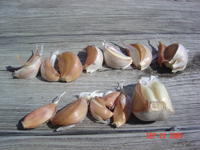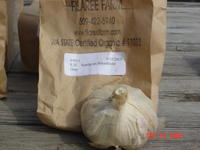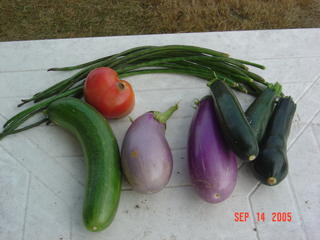
Bobwhite in the basil

Pullin' weeds and pickin' stones We are made of dreams and bones Need a place to grow my own 'Cause the time is close at hand ~ David Mallet
 I stuck my thumb in the intersection and brought up only dust ( it is still so dry here ) so I used my dish soap bottle filled with water, and squirted water into each hole. It is a very handy tool.
I stuck my thumb in the intersection and brought up only dust ( it is still so dry here ) so I used my dish soap bottle filled with water, and squirted water into each hole. It is a very handy tool. after year, so why not plant lots of it. I began by opening my two Ag Fair entries, the biggest and best I had. Inside the first head, I found 13 cloves of which only 7 were plantable. One clove was rejected because it was too big and was a double clove. Double cloves send up two plants neither of which does particularly well. The other cloves were too small to plant. Size of clove is related to size of next year’s heads. In the end it took 6 heads of Spanish Roja to plant 40 cloves.
after year, so why not plant lots of it. I began by opening my two Ag Fair entries, the biggest and best I had. Inside the first head, I found 13 cloves of which only 7 were plantable. One clove was rejected because it was too big and was a double clove. Double cloves send up two plants neither of which does particularly well. The other cloves were too small to plant. Size of clove is related to size of next year’s heads. In the end it took 6 heads of Spanish Roja to plant 40 cloves. I only have one other Rocambole and that is a new one from Filaree Farm called Sandpoint. I opened the bag and to my surprise one quarter pound of seed garlic = one head, and a huge head it was! I was able to get the 10 cloves needed to give me one row of Sandpoint.
I only have one other Rocambole and that is a new one from Filaree Farm called Sandpoint. I opened the bag and to my surprise one quarter pound of seed garlic = one head, and a huge head it was! I was able to get the 10 cloves needed to give me one row of Sandpoint. a bee working diligently on what few blooms she could find. I have to hand it to this one zucchini plant of mine that is still producing. Somehow it dodged the squash vine borer attack that laid the others low. I’m happy just to see it blooming still each morning.
a bee working diligently on what few blooms she could find. I have to hand it to this one zucchini plant of mine that is still producing. Somehow it dodged the squash vine borer attack that laid the others low. I’m happy just to see it blooming still each morning.
 Vermont Cranberry Beans (many of which I ate as shell beans earlier) and the speckled ones are Rattlesnake pole beans. I’m not sure the beans are a good use of garden space. After all, what is cheaper in the store than a bag of dried beans?
Vermont Cranberry Beans (many of which I ate as shell beans earlier) and the speckled ones are Rattlesnake pole beans. I’m not sure the beans are a good use of garden space. After all, what is cheaper in the store than a bag of dried beans?
